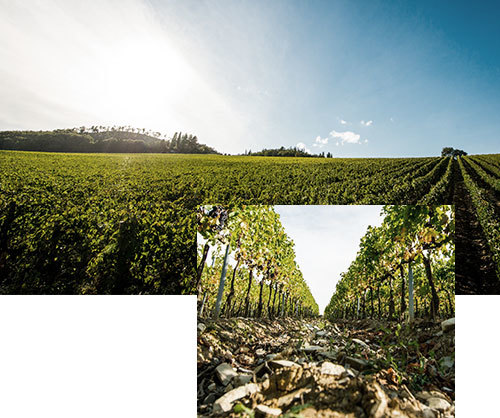Vineyards
 After purchasing the estate in 1973, Ivo Nuti quickly realised that he could – and must – expect more from the vines. Starting in 1997, the old vines – which had become unproductive – were systematically replaced with the best and most suitable varieties for the specific soil and climate conditions at Fattoria Montecchio: Sangiovese, Cabernet Sauvignon, Merlot and Alicante.
After purchasing the estate in 1973, Ivo Nuti quickly realised that he could – and must – expect more from the vines. Starting in 1997, the old vines – which had become unproductive – were systematically replaced with the best and most suitable varieties for the specific soil and climate conditions at Fattoria Montecchio: Sangiovese, Cabernet Sauvignon, Merlot and Alicante.
Studies were undertaken into the best growing style for each area, with spurred cordon alternating with guyot, a technique used mainly for the more recently planted vines and only with the Sangiovese variety.
We also employ green harvesting, which is done a few months before the harvest itself to ensure quality. This has been a fundamental part of rebalancing the production potential of the plants..
As is so often the case at large wineries, our vines aren’t one big organism, but a collection of different vineyards. All are located around Fattoria Montecchio, and each one has its own identity and characteristics which change based on exposure, the height of the vines, microclimate and the geological make-up of the land.
| Year of planting | 1997 |
|---|---|
| Size | Approx. four hectares |
| Plants per hectare | 6,250 |
| Growing system | Spurred cordon |
| Varieties | Sangiovese, Merlot and Cabernet Sauvignon |
| Orientation and exposure of vines | 335° with north-west exposure |
| Altitude | Between 375 and 415 meters above sea level |
| Type of terrain |
|
| Standard agronomic practices |
|
| Type of harvest | Initial hand-selection harvest followed by mechanical harvest |
| Year of planting | 2001-2002 |
|---|---|
| Size | Approx. 5 hectares |
| Plants per hectare | 6,250 |
| Growing system | Spurred cordon |
| Varieties | Cabernet Sauvignon, Alicante Bouschet |
| Orientation and exposure of vines | 115° with south-east exposure |
| Altitude | between 370 and 405 meters above sea level |
| Type of terrain |
|
| Standard agronomic practices |
|
| Type of harvest | Initial hand-selection harvest followed by mechanical harvest |
| Year of planting | 1998 |
|---|---|
| Size | Approx. 9.5 hectares |
| Plants per hectare | 6,250 |
| Growing system | Spurred cordon and Guyot |
| Varieties | Sangiovese, Merlot |
| Orientation and exposure of vines | 135° with south-east exposure |
| Altitude | between 300 and 350 meters above sea level |
| Type of terrain |
|
| Standard agronomic practices |
|
| Type of harvest | Initial hand-selection harvest followed by mechanical harvest |
| Year of planting | 2010 |
|---|---|
| Size | Approx. 5.5 hectares |
| Plants per hectare | 6,250 |
| Growing system | Spurred cordon |
| Varieties | Sangiovese |
| Orientation and exposure of vines | 215° with south-west exposure |
| Altitude | between 395 and 415 meters above sea level |
| Type of terrain |
|
| Standard agronomic practices |
|
| Type of harvest | Initial hand-selection harvest followed by mechanical harvest |
| Year of planting | 2017 |
|---|---|
| Size | Approx. 1.5 hectares |
| Plants per hectare | 5,435 |
| Growing system | Guyot |
| Varieties | Sangiovese |
| Orientation and exposure of vines | 240° with north-east exposure |
| Altitude | between 405 and 425 meters above sea level |
| Type of terrain |
|
| Standard agronomic practices |
|
| Type of harvest | Initial hand-selection harvest followed by mechanical harvest |
| Year of planting | 2016 |
|---|---|
| Size | Approx. 3.5 hectares |
| Plants per hectare | 5,435 |
| Growing system | Guyot |
| Varieties | Sangiovese |
| Orientation and exposure of vines | 170° with south-west exposure, 260° with south-west exposure |
| Altitude | between 390 and 415 meters above sea level |
| Type of terrain |
|
| Standard agronomic practices |
|
| Type of harvest | Initial hand-selection harvest followed by mechanical harvest |